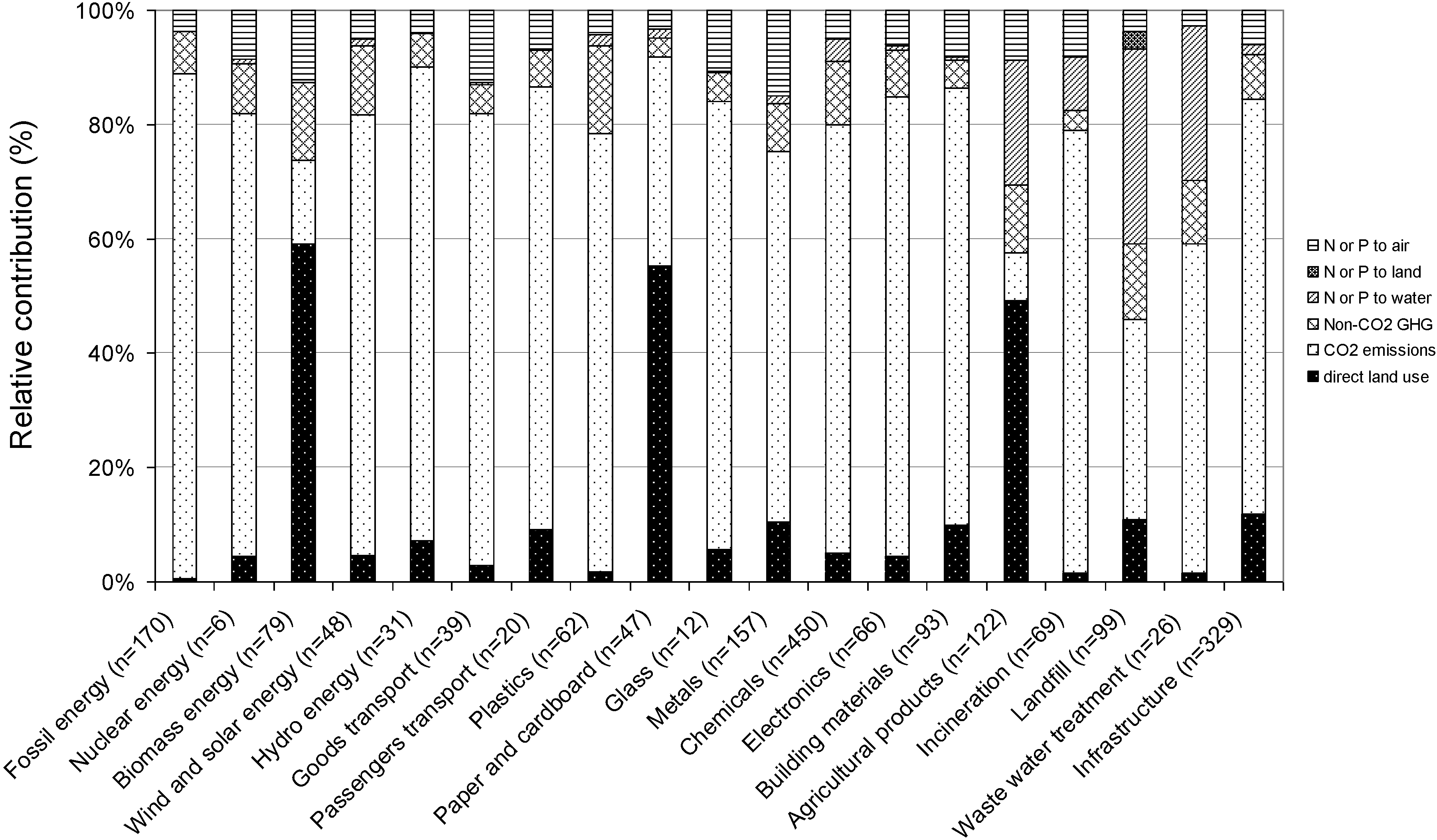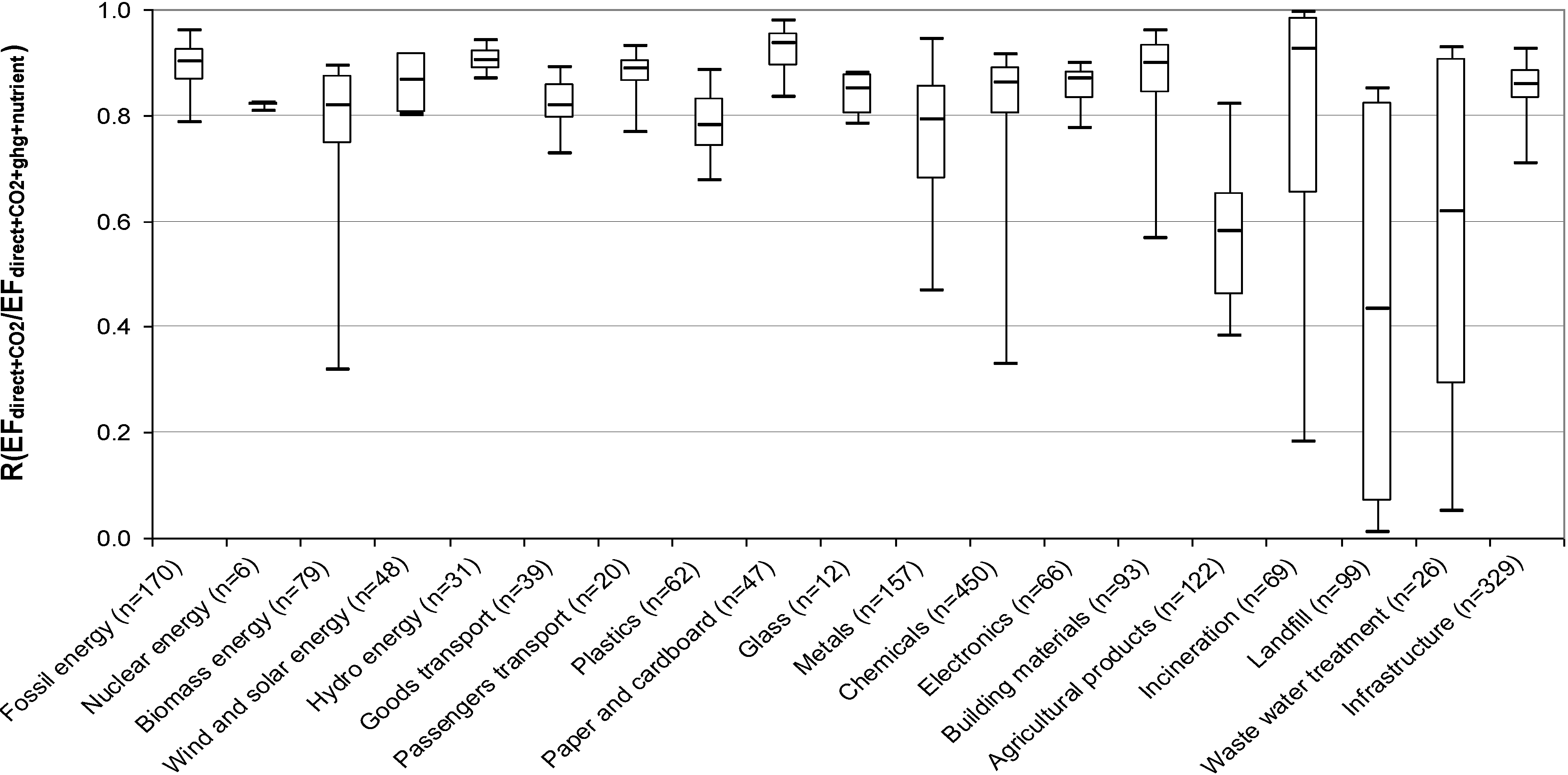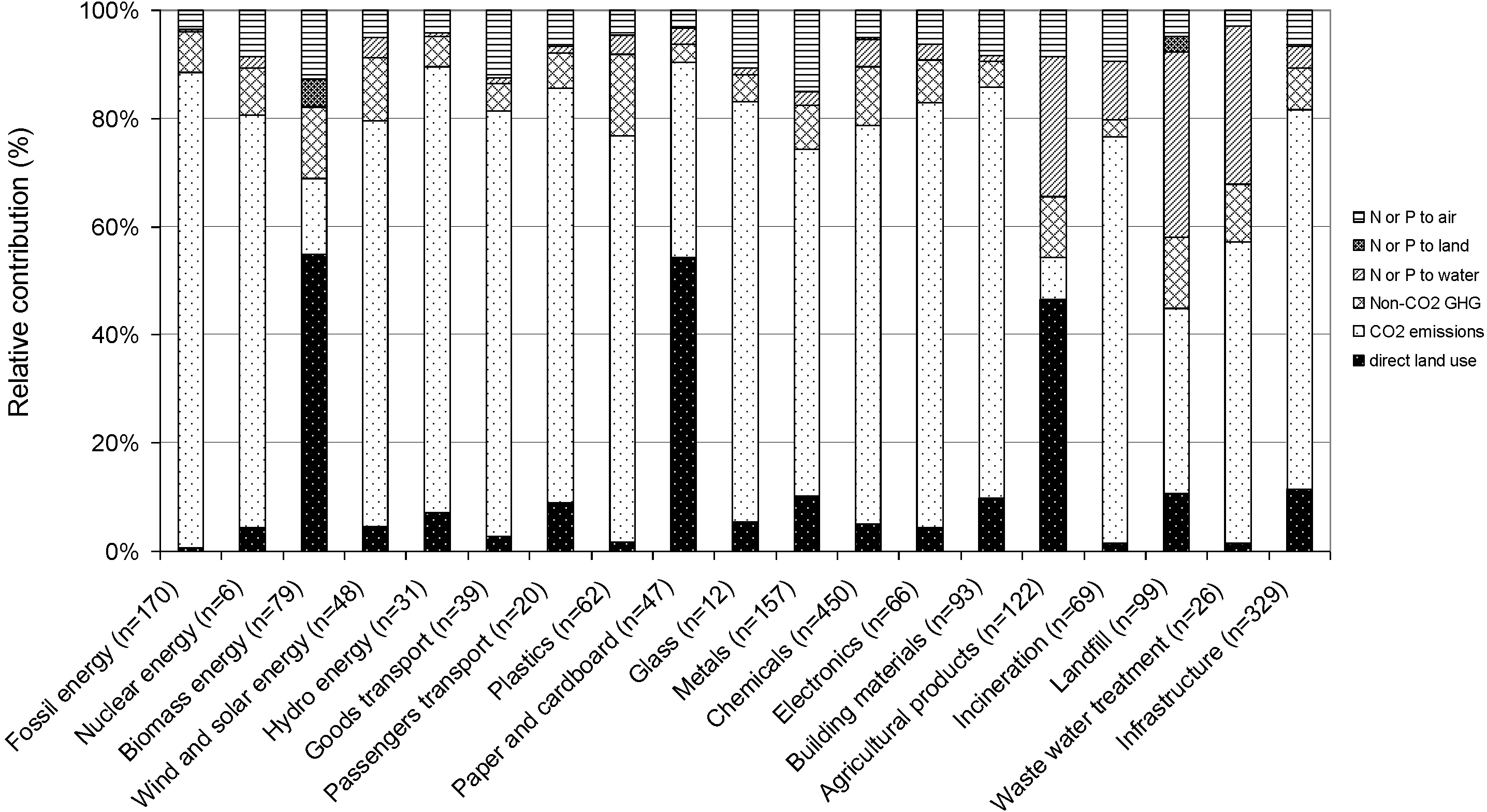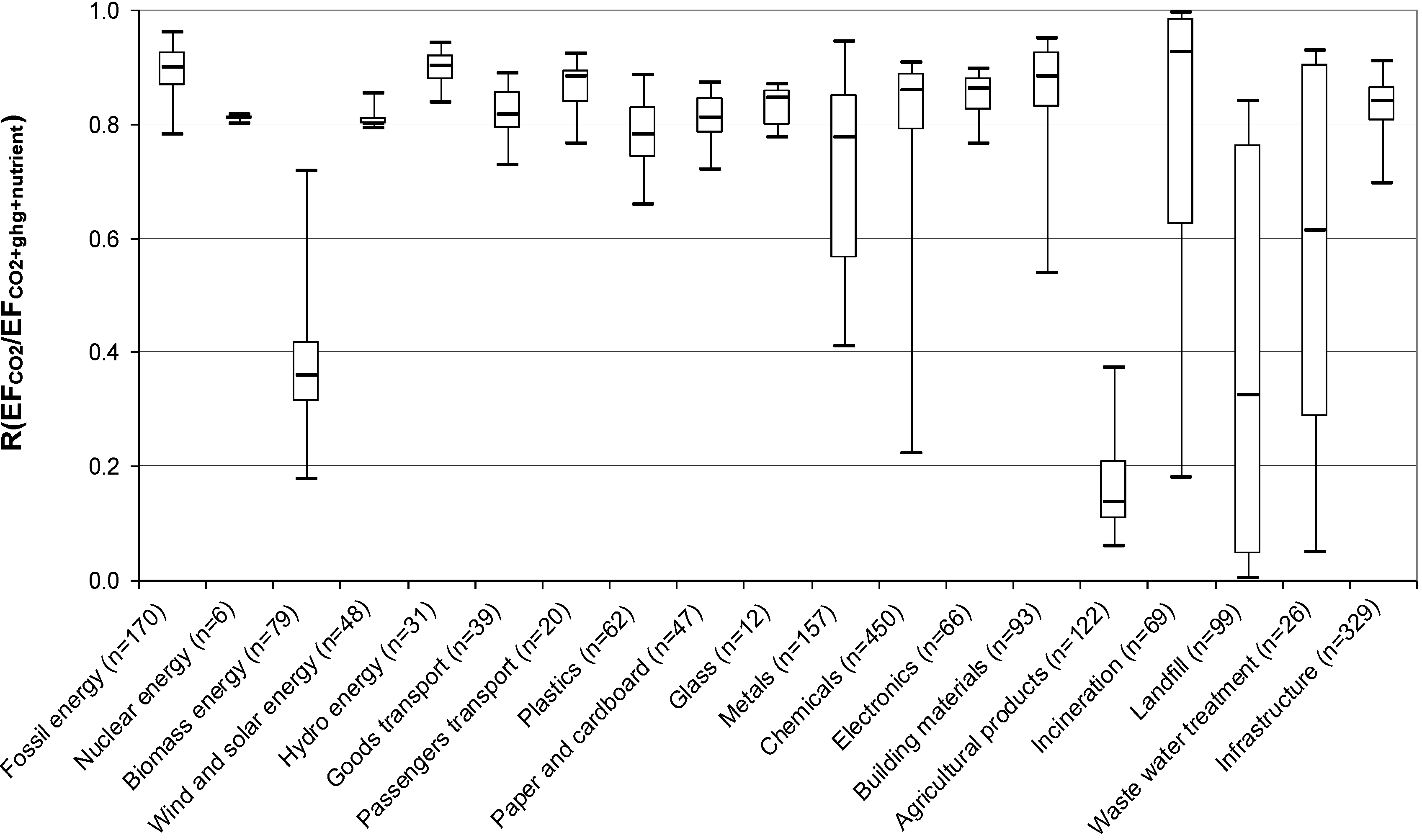The Influence of Nutrients and Non-CO2 Greenhouse Gas Emissions on the Ecological Footprint of Products
Abstract
:1. Introduction
2. Methods
2.1. Original EF Method
| Parameter | Abbrev. | Unit | Value | References |
|---|---|---|---|---|
| Equivalence factor of forest area | EqFf | - | 1.4 | Wackernagel et al. [7] |
| Equivalence factor of urban area | EqFu | - | 2.2 | Wackernagel et al. [7] |
| Equivalence factor of arable land | EqFa | - | 2.2 | Wackernagel et al. [7] |
| Equivalence factor of pasture area | EqFp | - | 0.5 | Wackernagel et al. [7] |
| Equivalence factor of area required for hydropower | EqFh | - | 1 | Wackernagel et al. [7] |
| Equivalence factor of marine area | EqFm | - | 0.4 | Wackernagel et al. [7] |
| Fraction of CO2 absorbed by oceans | FCO2 | - | 0.3 | Wackernagel et al. [7] |
| Sequestration rate of CO2 by biomass | SCO2 | kg CO2 m–2 yr–1 | 0.4 | Wackernagel et al. [7] |
| Phosphorus uptake in agricultural soils | UP | kg P m–2 yr–1 | 0.0009 | Antikainen and Haapanen [36] |
| Nitrogen uptake in agricultural soils | UN | Kg N m–2 yr–1 | 0.0062 | Antikainen and Haapanen [36] |
| Denitrification rate in agricultural soils | DN | kg N m–2 yr–1 | 0.0065 | Hofstra and Bouwman [37] |
2.2. Modified EF Method
2.2.1. Greenhouse Gas Emissions
2.2.2. Nutrient Emissions
2.3. Product Database
| Product group | Unit | Number of products |
|---|---|---|
| Fossil energy a | MJ | 170 |
| Nuclear energy | MJ | 6 |
| Biomass energy | MJ | 79 |
| Wind and solar energy | MJ | 48 |
| Hydro energy | MJ | 31 |
| Building materials b | kg | 93 |
| Metals | kg | 157 |
| Plastics | kg | 62 |
| Paper and cardboard | kg | 47 |
| Chemicals c | kg | 450 |
| Glass d | kg | 12 |
| Electronics | kg | 66 |
| Agricultural products e | kg | 122 |
| Landfill f | kg | 99 |
| Incineration g | kg | 69 |
| Waste water | m3 | 26 |
| Goods transport | tkm | 39 |
| Passengers transport | pkm | 20 |
| Infrastructure | unit | 329 |
2.4. Data Analysis
3. Results


4. Discussion
4.1. Non-CO2 Greenhouse Gas Emissions
4.2. Nutrient Emissions
4.3. Comparison to Previous Studies
5. Conclusions
References
- Living Planet Report 2008; World Wide Fund (WWF): Gland, Switzerland, 2008. Available online: www.panda.org/livingplanet (accessed on 2 November 2009).
- Rees, W. Ecological footprints and appropriated carrying capacity: What urban economics leaves out. Environ. Urban. 1992, 4, 121–130. [Google Scholar] [CrossRef]
- Rees, W.; Wackernagel, M. Ecological footprints and appropriated carrying capacity: Measuring the natural capital requirements of the human economy. In Investing in Natural Capital: The Ecological Economics Approach to Sustainability; Jansson, A.M., Hammer, M., Folke, C., Costanza, R., Eds.; Island Press: Washington, DC, USA, 1994; pp. 362–390. [Google Scholar]
- Wackernagel, M.; Rees, W. Our Ecological Footprint. Reducing Human Impact on the Earth; New Society Publisher: Gabriola Island, Canada, 1996. [Google Scholar]
- Chambers, N.; Simmons, C.; Wackernagel, M. Sharing Nature’s Interest: Ecological Footprints as an Indicator of Sustainability; Earthscan: London, UK, 2000. [Google Scholar]
- Lenzen, M.; Hansson, C.B.; Bond, S. On the bioproductivity and land-disturbance metrics of the Ecological Footprint. Ecol. Econ. 2007, 61, 6–10. [Google Scholar] [CrossRef]
- Wackernagel, M.; Monfreda, C.; Moran, D.; Wermer, P.; Goldfinger, S.; Deumling, D.; Murray, M. National Footprint and Biocapacity Accounts 2005: The Underlying Calculation Method; Global Footprint Network: Oakland, CA, USA, 2005. [Google Scholar]
- Bicknell, K.B.; Ball, R.J.; Cullen, R.; Bigsby, H.R. New methodology for the Ecological Footprint with an application to the New Zealand economy. Ecol. Econ. 1998, 27, 149–160. [Google Scholar] [CrossRef]
- van Vuuren, D.P.; Smeets, E.M.W. Ecological Footprints of Benin, Bhutan, Costa Rica and The Netherlands. Ecol. Econ. 2000, 34, 115–130. [Google Scholar]
- Haberl, H.; Erb, K.H.; Krausmann, F. How to calculate and interpret ecological footprints for long periods of time: The case of Austria 1926–1995. Ecol. Econ. 2001, 38, 25–45. [Google Scholar] [CrossRef]
- Lenzen, M.; Murray, S.A. A modified ecological footprint method and its application to Australia. Ecol. Econ. 2001, 37, 229–255. [Google Scholar] [CrossRef]
- Simmons, C.; Lewis, K.; Giljum, S.; Best, A. Assessing the Quality of the National Footprint Accounts Using Germany as a Case Study. In Proceedings of the International Ecological Footprint Conference, Cardiff, UK, 8–10 May 2007.
- Folke, C.; Jansson, A.; Larsson, J.; Costanza, R. Ecosystem appropriation by cities. Ambio 1997, 26, 167–172. [Google Scholar]
- McDonald, G.W.; Patterson, M.G. Ecological footprints and interdependencies of New Zealand regions. Ecol. Econ. 2004, 50, 49–67. [Google Scholar] [CrossRef]
- Collins, A.; Flynn, A.; Wiedmann, T.; Barrett, J. The environmental impacts of consumption at a subnational level. J. Ind. Ecol. 2006, 10, 9–24. [Google Scholar] [CrossRef]
- Kissinger, M.; Fix, J.; Rees, W.E. Wood and non-wood pulp production: Comparative ecological footprint on the Canadian prairies. Ecol. Econ. 2007, 62, 552–558. [Google Scholar] [CrossRef]
- Huijbregts, M.A.J.; Hellweg, S.; Frischknecht, R.; Hungerbuhler, K.; Hendriks, A.J. Ecological footprint accounting in the life cycle assessment of products. Ecol. Econ. 2008, 64, 798–807. [Google Scholar] [CrossRef]
- Lenzen, M.; Murray, J.; Sack, F.; Wiedmann, T. Shared producer and consumer responsibility—Theory and practice. Ecol. Econ. 2007, 61, 27–42. [Google Scholar] [CrossRef]
- Rees, W. Eco-footprint analysis: Merits and brickbats. Ecol. Econ. 2000, 32, 371–374. [Google Scholar] [CrossRef]
- Fiala, N. Measuring sustainability: Why the ecological footprint is bad economics and environmental science. Ecol. Econ. 2008, 67, 519–525. [Google Scholar] [CrossRef]
- Walsh, C.; O’Regan, B.; Moles, R. Incorporating methane into ecological footprint analysis: A case study of Ireland. Ecol. Econ. 2009, 68, 1952–1962. [Google Scholar] [CrossRef]
- Lenzen, M.; Wiedmann, T.; Foran, B.; Dey, C.; Widmer-Cooper, A.; William, M.; Ohlemüller, R. Forecasting the Ecological Footprint of Nations: A Blueprint for a Dynamic Approach; ISA Research Report 07–01; Centre for Integrated Sustainability Analysis at the University of Sydney: NSW, Australia; Stockholm Environmental Institute at the University of York: York, UK, 2007. [Google Scholar]
- van der Bergh, J.C.J.M.; Verbruggen, H. Spatial sustainability, trade and indicators: An evaluation of the “ecological footprint”. Ecol. Econ. 1999, 29, 61–72. [Google Scholar] [CrossRef]
- Turner, K.; Lenzen, M.; Wiedmann, T.; Barrett, J. Examining the global environmental impact of regional consumption activities—Part 1: A technical note on combining input-output and Ecological Footprint analysis. Ecol. Econ. 2007, 62, 37–44. [Google Scholar] [CrossRef]
- Wiedmann, T. A first empirical comparison of energy footprints embodied in trade—MRIO versus PLUM. Ecol. Econ. 2009, 68, 1975–1990. [Google Scholar] [CrossRef]
- Ayers, R.U. Commentary on the utility of the Ecological Footprint concept. Ecol. Econ. 2000, 32, 347–349. [Google Scholar] [CrossRef]
- Moffatt, I. Ecological footprints and sustainable development. Ecol. Econ. 2000, 32, 359–362. [Google Scholar] [CrossRef]
- van Kooten, G.C.; Bulte, E.H. The ecological footprint—Useful science or politics? Ecol. Econ. 2000, 32, 385–389. [Google Scholar] [CrossRef]
- Ferng, J.J. Toward a scenario analysis framework for energy footprints. Ecol. Econ. 2002, 40, 53–69. [Google Scholar] [CrossRef]
- Kitzes, J.; Galli, A.; Bagliani, M.; Barrett, J.; Dige, G.; Ede, S.; Erb, K.; Giljum, S.; Haberl, H.; Hails, C.; Jolia-Ferrier, L.; Jungwirth, S.; Lenzen, M.; Lewis, K.; Loh, J.; Marchettini, N.; Messinger, H.; Milne, K.; Moles, R.; Monfreda, C.; Moran, D.; Nakano, K.; Pyhälä, A.; Rees, W.; Simmons, C.; Wackernagel, M.; Wada, Y.; Walsh, C.; Wiedmann, T. A research agenda for improving national ecological footprint accounts. Ecol. Econ. 2009, 68, 1991–2007. [Google Scholar] [CrossRef]
- Ecoinvent Centre. Ecoinvent Data v2.0. Ecoinvent Report No.1. Overview and Methodology; Swiss Centre for Life Cycle Inventories: Dübendorf, Switzerland, 2007. [Google Scholar]
- Wiedmann, T.; Lenzen, M. On the conversion between local and global hectares in ecological footprint analysis. Ecol. Econ. 2007, 60, 673–677. [Google Scholar] [CrossRef]
- Finnveden, G.; Hauschild, M.Z.; Ekvall, T.; Guinee, J.; Heijungs, R.; Hellweg, S.; Koehler, A.; Pennington, D.; Suh, S. Recent developments in life cycle assessment. J. Environ. Manage. 2009, 91, 1–21. [Google Scholar] [CrossRef] [PubMed]
- The AR4 Synthesis Report. Contribution of Working Group to the Fourth Assessment Report of the Intergovernmental Panel on Climate Change; Intergovernmental Panel on Climate Change (IPCC): Geneva, Switzerland, 2007.
- Synthesis Report. Contribution of Working Group I to the Third Assessment Report of the Intergovernmental Panel on Climate Change; Cambridge University Press: Cambridge, UK, 2001.
- Antikainen, R.; Haapanen, R. Nitrogen and Phosphorus flows in the Finnish agricultural and forest sectors, 1910–2000. Water Air Soil Pollut. 2008, 194, 163–177. [Google Scholar] [CrossRef]
- Hofstra, N.; Bouwman, A.F. Denitrification in agricultural soils: Summarizing published data and estimating global annual rates. Nutr. Cycling Agroecosyst. 2005, 72, 267–278. [Google Scholar] [CrossRef]
- Holmberg, J.; Lundqvist, U.; Robèrt, K.H.; Wackernagel, M. The Ecological Footprint from a Systems Perspective of Sustainability. Int. J. Sust. Dev. World 1999, 6, 17–33. [Google Scholar] [CrossRef]
- Forster, P.; Ramaswamy, V.; Artaxo, P.; Berntsen, T.; Betts, R.; Fahey, D.W.; Haywood, J.; Lean, J.; Lowe, D.C.; Myhre, G.; Nganga, J.; Prinn, R.; Raga, G.; Schulz, M.; van Dorland, R. Changes in atmospheric constituents and in radiative forcing. In Climate Change 2007: The Physical Science Basis. Contribution of Working Group I to the Fourth Assessment Report of the Intergovernmental Panel on Climate Change; Solomon, S., Qin, D., Manning, M., Chen, Z., Marquis, M., Averyt, K.B., Tignor, M., Miller, H.L., Eds.; Cambridge University Press: Cambridge, UK, 2007. [Google Scholar]
- Updated UNFCCC Reporting Guidelines on Annual Inventories Following Incorporation of the Provisions of Decision 14/CP.11; Note by the secretariat of UNFCCC; United Nations Office: Geneva, Switzerland, 2006.
- Stoeglehner, G.; Narodoslawsky, M. Implementing ecological footprinting in decision-making processes. Land Use Policy 2008, 25, 421–431. [Google Scholar] [CrossRef]
- Nguyen, H.X.; Yamamoto, R. Modification of ecological footprint evaluation method to include non-renewable resource consumption using thermodynamic approach. Resour. Conserv. Recycl. 2007, 51, 870–884. [Google Scholar] [CrossRef]
Appendix A
| Ecoinvent classification | EqF for direct land use type (dimensionless) |
|---|---|
| Occupation, arable | 2.2 |
| Occupation, arable, non-irrigated | 2.2 |
| Occupation, construction site | 2.2 |
| Occupation, dump site | 2.2 |
| Occupation, dump site, benthos | 0.4 |
| Occupation, forest | 1.4 |
| Occupation, forest, intensive | 1.4 |
| Occupation, forest, intensive, normal | 1.4 |
| Occupation, industrial area | 2.2 |
| Occupation, industrial area, benthos | 0.4 |
| Occupation, industrial area, built up | 2.2 |
| Occupation, industrial area, vegetation | 2.2 |
| Occupation, mineral extraction site | 2.2 |
| Occupation, pasture and meadow | 0.5 |
| Occupation, pasture and meadow, extensive | 0.5 |
| Occupation, pasture and meadow, intensive | 0.5 |
| Occupation, permanent crop | 2.2 |
| Occupation, permanent crop, fruit | 2.2 |
| Occupation, permanent crop, fruit, intensive | 2.2 |
| Occupation, shrub land, sclerophyllous | 1.4 |
| Occupation, traffic area, rail embankment | 2.2 |
| Occupation, traffic area, rail network | 2.2 |
| Occupation, traffic area, road embankment | 2.2 |
| Occupation, traffic area, road network | 2.2 |
| Occupation, urban, discontinuously built | 2.2 |
| Occupation, water bodies, artificial | 1 |
| Occupation, water courses, artificial | 1 |
Appendix B
| Greenhouse gases | GWP 100a (kg CO2-equivalents kg–1) |
|---|---|
| carbon dioxide | 1 |
| carbon monoxide, fossil | 1.6* |
| chloroform | 30* |
| dinitrogen monoxide | 298 |
| ethane, pentafluoro-, HFC-125 | 3,500 |
| ethane, hexafluoro-, HFC 116 | 12,200 |
| ethane, chloropentafluoro-, CFC-115 | 7,370 |
| ethane, 2-chloro-1,1,1,2-tetra-fluoro-, HCFC-124 | 609 |
| ethane, 2,2-dichloro-1,1,1-tri-fluoro-, HCFC-123 | 77 |
| ethane, 1-chloro-1,1-difluoro-, HCFC-142b | 2,310 |
| ethane, 1,2-dichloro-1,1,2,2-tetrafluoro-, CFC-114 | 10,000 |
| ethane, 1,1-difluoro-, HFC-152a | 124 |
| ethane, 1,1-dichloro-1-fluoro-, HCFC-141b | 725 |
| ethane, 1,1,2-trichloro-1,2,2-trifluoro-, CFC-113 | 6,130 |
| ethane, 1,1,1-trifluoro-, HFC-143a | 4,470 |
| ethane, 1,1,1,2-tetrafluoro-, HFC-134a | 1,430 |
| methane | 25 |
| methane, bromo-, Halon 1001 | 5 |
| methane, bromochlorodifluoro-, Halon 1211 | 1,890 |
| methane, bromotrifluoro-, Halon 1301 | 7,140 |
| methane, chlorodifluoro-, HCFC-22 | 1,810 |
| methane, chlorotrifluoro-, CFC-13 | 14,400 |
| methane, dichloro-, HCC-30 | 8.7 |
| methane, dichlorodifluoro-, CFC-12 | 10,900 |
| methane, dichlorofluoro-, HCFC-21 | 210* |
| methane, difluoro-, HFC-32 | 675 |
| methane, monochloro-, R-40 | 13 |
| methane, tetrachloro-, R-10 | 1,400 |
| methane, tetrafluoro-, R-14 | 7,390 |
| methane, trichlorofluoro-, CFC-11 | 4,600 |
| methane, trifluoro-, HFC-23 | 14,800 |
| sulfur hexafluoride | 22,800 |
Appendix C
| Compartment | Compound | Molar mass of compound (g/mol) | Molar mass conversion factor |
|---|---|---|---|
| Water (freshwater, ocean, groundwater and unspecified) | N (nitrogen) | 14 | 1 |
| NO3– (nitrate) | 62 | 14/62 | |
| NO2– (nitrite) | 46 | 14/46 | |
| P (phosphorus) | 31 | 1 | |
| PO43– (phosphate) | 95 | 31/95 | |
| Soil | N (nitrogen)-industrial | 14 | 1 |
| P (phosphorus)-industrial | 31 | 1 | |
| Air (high population density, low population density, lower stratosphere and unspecified) | NO3– (nitrate) | 62 | 14/62 |
| NO2 (nitrogen oxides) | 44 | 14/44 | |
| NH3 (ammonia) | 17 | 14/17 | |
| P (phosphorus) | 31 | 1 |
Appendix D


© 2010 by the authors; licensee Molecular Diversity Preservation International, Basel, Switzerland. This article is an open-access article distributed under the terms and conditions of the Creative Commons Attribution license (http://creativecommons.org/licenses/by/3.0/).
Share and Cite
Hanafiah, M.M.; Huijbregts, M.A.J.; Hendriks, A.J. The Influence of Nutrients and Non-CO2 Greenhouse Gas Emissions on the Ecological Footprint of Products. Sustainability 2010, 2, 963-979. https://doi.org/10.3390/su2040963
Hanafiah MM, Huijbregts MAJ, Hendriks AJ. The Influence of Nutrients and Non-CO2 Greenhouse Gas Emissions on the Ecological Footprint of Products. Sustainability. 2010; 2(4):963-979. https://doi.org/10.3390/su2040963
Chicago/Turabian StyleHanafiah, Marlia M., Mark A.J. Huijbregts, and A. Jan Hendriks. 2010. "The Influence of Nutrients and Non-CO2 Greenhouse Gas Emissions on the Ecological Footprint of Products" Sustainability 2, no. 4: 963-979. https://doi.org/10.3390/su2040963
APA StyleHanafiah, M. M., Huijbregts, M. A. J., & Hendriks, A. J. (2010). The Influence of Nutrients and Non-CO2 Greenhouse Gas Emissions on the Ecological Footprint of Products. Sustainability, 2(4), 963-979. https://doi.org/10.3390/su2040963




